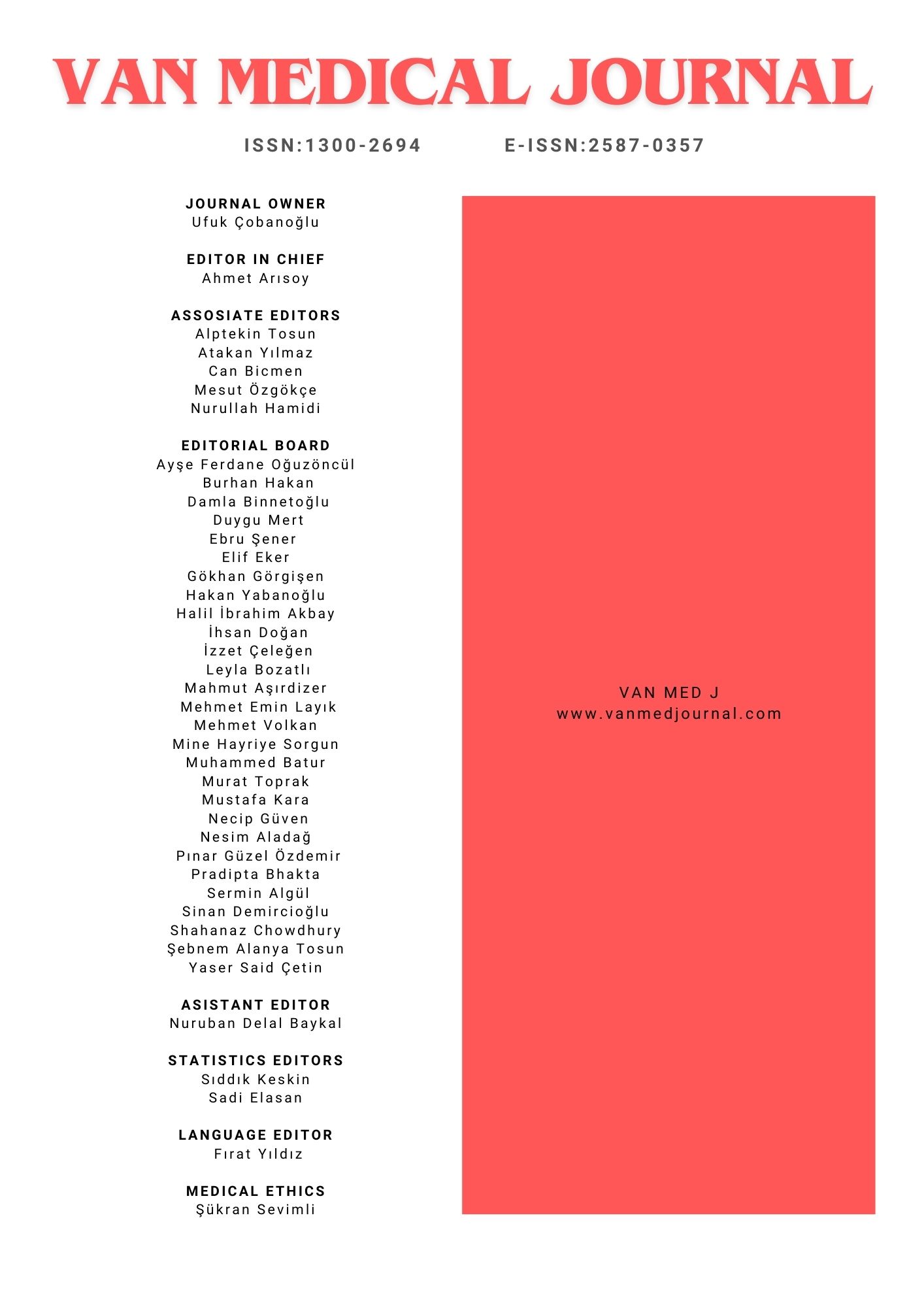Comparison of LISA and INSURE Methods in Surfactant Application in Preterm Babies with Respiratory Distress Syndrome
Neşet Aydın1, İbrahim Deger2, Murat Başaranoğlu3, Nihat Demir4, Oğuz Tuncer51Health Sciences University Van Regional Training And Research Hospital, Pediatrics, Van2Dicle University Faculty Of Medicine, Neonatology Department, Diyarbakır
3Health Sciences University Van Regional Training And Research Hospital, Neonatology, Van
4Private Esenyurt Hospital, Neonatology, Istanbul
5Yüzüncü Yıl University Faculty Of Medicine, Department Of Neonatology, Van
INTRODUCTION: This study was conducted to compare the use of surfactant by invasive (intubation tube) and less invasive (thin catheter) methods in preterm babies who received surfactant treatment with the diagnosis of respiratory distress syndrome.
METHODS: The babies whose gestational week was 32nd gestational week and/or below and who needed surfactant treatment were included in the study. Sixty patients who needed surfactant replacement for respiratory distress syndrome were included in the study. Poractant alfa (200 mg/kg/dose) was given to all cases. The cases were randomized into LISA and INSURE group.
RESULTS: During the administration of surfactant, no complications were observed in 90% of the patients in the INSURE group and in 63.3% of the patients in the LISA group. In the LISA group, it was found that intubation was significantly lower in the first 72 hours in terms of flow. It was found that the need for mechanical ventilation and mortality rates were higher in INSURE. No citations were found among the groups when he asked for repeated surfactant. There was no significant feature among the groups in terms of Respiratory distress syndrome complications.
DISCUSSION AND CONCLUSION: Both methods can be used in surfactant replacement therapy, but desaturation is more common during surfactant treatment with a thin catheter. Application difficulties of the catheter method are the disadvantages of the method. However, it seems more successful than the INSURE method because it does not require intubation and positive pressure ventilation, the need for mechanical ventilation support and the duration of stay in mechanical ventilation is less.
Respiratuvar Distres Sendromlu Preterm Bebeklerde Sürfaktan Uygulanmasında LISA ve INSURE Yöntemlerinin Karşılaştırılması
Neşet Aydın1, İbrahim Deger2, Murat Başaranoğlu3, Nihat Demir4, Oğuz Tuncer51Sağlık Bilimleri Üniversitesi Van Bölge Eğitim Ve Araştırma Hastanesi, Çocuk Sağlığı Ve Hastalıkları, Van2Dicle Üniversitesi Tıp Fakültesi, Neonatoloji Bilim Dalı, Diyarbakır
3Sağlık Bilimleri Üniversitesi Van Bölge Eğitim Ve Araştırma Hastanesi, Neonatoloji, Van
4Özel Esenyurt Hastanesi, Neonatoloji, İstanbul
5Yüzüncü Yıl Üniversitesi Tıp Fakültesi, Neonatoloji Bilim Dalı, Van
GİRİŞ ve AMAÇ: Bu çalışma, respiratuvar distres sendromu tanısıyla sürfaktan tedavisi uygulanan prematüre bebeklerde, invaziv (entübasyon tüpü) ve daha az invaziv (ince kateter) yöntemlerle sürfaktan uygulanmasının karşılaştırılması amacıyla yapıldı.
YÖNTEM ve GEREÇLER: Yenidoğan Yoğun Bakım ünitesinde yatan; doğum haftası 32. gebelik haftası ve/veya altında olan ve sürfaktan tedavisi verilmesi gereken bebekler çalışmaya alındı. Respiratuvar distres sendromu için sürfaktan replasmanı gereken 60 olgu çalışmaya alındı. Tüm olgulara poractant alfa (200 mg/kg/doz) verildi. Olgular, LISA (Daha az invaziv sürfaktan uygulaması) ve INSURE (Entübasyon, Sürfaktan uygulaması ve Ekstübasyon) grubu olacak şekilde randomize edildi.
BULGULAR: Sürfaktan verilişi sırasında INSURE grubundaki hastaların %90’ında, LISA grubundaki hastaların ise %63.3’ünde komplikasyon gözlenmedi. LISA grubunda ilk 72 saatte entübasyon ihtiyacının istatistiksel olarak anlamlı oranda daha düşük olduğu saptandı. Mekanik ventilasyon ihtiyacının ve ölüm oranlarının INSURE grubunda daha yüksek olduğu saptandı. Tekrarlayan sürfaktan ihtiyacı açısından gruplar arasında anlamlı farklılık bulunmadı. Gruplar arasında Respiratuvar distres sendromu komplikasyonları (Nekrotizan enterokolit, İntrakraniyal kanama, Prematüre retinopatisi, Bronkopulmoner displazi) yönünden istatistiksel olarak anlamlı farklılık bulunmadı.
TARTIŞMA ve SONUÇ: Sürfaktan replasman tedavisinde her iki yöntem de uygulanabilir ancak ince kateter ile sürfaktan tedavisi sırasında desatürasyon daha sık görülmektedir. Kateter yönteminin uygulama zorlukları yöntemin dezavantajlarıdır. Fakat entübasyon ve pozitif basınçlı ventilasyon gerektirmemesi, mekanik ventilasyon destek ihtiyacının ve mekanik ventilasyonda kalış süresinin daha az olması nedeniyle INSURE yöntemine göre daha başarılı görünmektedir.
Corresponding Author: İbrahim Deger, Türkiye
Manuscript Language: Turkish

